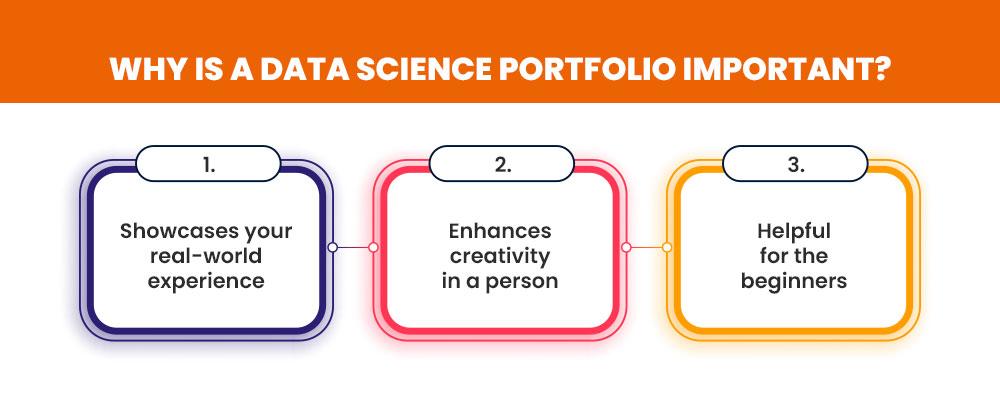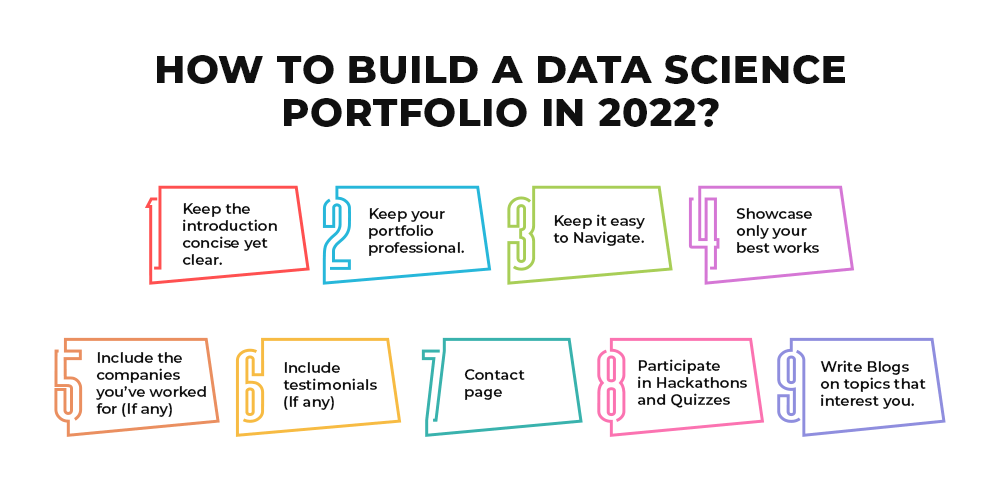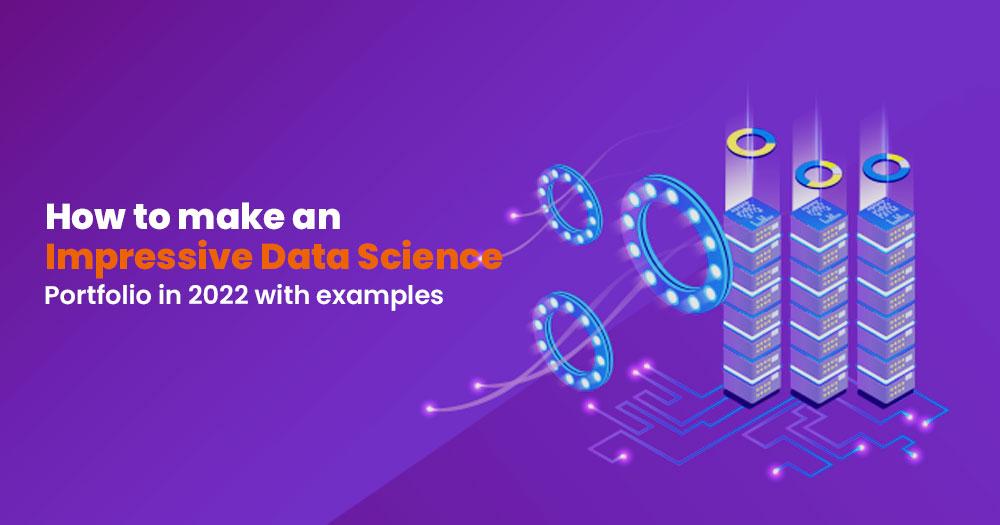There was a time in the data science industry when recruiters used to consider one’s CV or Resume to select them for the position. Now, the time has evolved, and in this developed era, a CV is nothing but a piece of paper or just a pdf file. Recruiters have become more skill focused rather than focusing on experience or qualification. And there’s no better way to express your skills than building kickass projects. But, building good data science projects is of no use if we can’t present them to the recruiters or the community in an effective way. Thus, it is said to build up your data science portfolio to present these projects. So, without any further due, let’s understand what a data science portfolio is and how to build data science portfolio in 2024.
What Is A Data Science Portfolio?
A data science portfolio is an organized and interactive collection of the best projects and contributions made by a person in the field of data science. A portfolio not only displays the skills to the recruiter but also conveys how good a person is at communication. Hence, it becomes really important for a data scientist to make a portfolio that stands out.
Why Is A Data Science Portfolio Important?

Getting a job is believed to be the main reason why most data scientists build a portfolio for themselves. However, it is not just the one. Some more reasons why one should consider building a data science portfolio are listed below:
Showcases Your Real-world Experience
A portfolio is a mirror of a person’s real-life experience with problems related to the field of data science. A good portfolio consists of the achievements and contributions of a person and hence makes a recruiter analyze them properly.
Enhances Creativity In A Person
A portfolio needs to be catchy and, at the same time, be minimal to grab the recruiter’s attention. Hence, while creating one, a person needs to pay attention to every detail, be it design or the flow of content. In this way, it leads to the enhancement of creativity in data scientists.
Helpful For The Beginners
We all are aware of how hard it is to get a job as a beginner in any field. And when it comes to data science, where there is such cut-throat competition, it becomes even harder to land a job as a beginner. But, with a suitable skill set and an impressive portfolio showcasing the skills, even a beginner in data science can land a job or an internship. Thus, it is imperative to have an attractive and balanced portfolio.
As we just read how important it is to have a portfolio, let’s now understand how to build an impressive data science portfolio in 2024.
You may also like to read: Top Benefits of Learning Data Science
How To Build A Data Science Portfolio In 2024?

The art of building an impressive portfolio is not something that can be learnt or taught. It is a process of trial and error until you make the best data science portfolio that works for you. And while designing your ideal data science portfolio template, the following points should be kept in mind:
Keep the introduction concise yet clear.
Writing “I am a data scientist/analyst” or “I am a deep learning expert” is not enough in today’s time. Therefore, it is advised to mention your qualification, experiences and future goals in the portfolio. This not only helps the recruiter to understand you better but also helps in building connections with other people of the same niche.
Keep your portfolio professional.
It is highly advised to keep the portfolio website professional. Nowadays, semi-professional designs are also in trend. However, it should always be kept in mind that the portfolio will go through the eyes of big recruiters, and hence it should feel casual or distractive while surfing.
It should be kept in mind that the person going through the portfolio should not get confused and can go from one page or section to another with feasibility.
Showcase only your best works (Less is always more)
This is one of the common mistakes which happens while designing a data science portfolio for beginners. Beginners tend to list every project they have worked on without thinking about its relevance. But only some projects are worth the attention of the recruiters. Hence, it is advised to list projects with famous yet relevant topics or programs.
Include the companies you’ve worked for (If any)
If your projects include working for famous companies or open-source organizations, it is advised to have them in the portfolio. Also, mention the role you performed.
Include testimonials (If any)
Testimonials cannot be expected while going through the data science portfolio for beginners. But if you have worked for people or organizations that have given you good feedback, include them in your portfolio.
Contact page
Well, in case your projects excite someone, where will they go? So, provide accurate contact details like your mail, contact, or GitHub.
Participate in Hackathons and Quizzes
Participating in hackathons and quizzes enhances your skills and helps in portfolio building.
You may also like to read: Data Science Interview Questions and Answers
Write Blogs on topics that interest you.
Last but not least, write informative blogs on topics that you’re confident of. Include your code and project details as examples. In the end, include a CTA (Call to Action) to convert potential readers into customers.
Data Science Portfolio Examples
As stated earlier, the best data science portfolio is the one that works for you. However, it is not a sin to get inspired from other data science portfolio examples and build your data science portfolio template.
Some examples of best data science portfolios are:
Source: CareerFoundry
Platforms For Hosting Your Portfolio
Although, having your portfolio website is considered to be best. There are some other platforms as well that provide feasibility to the data scientists in listing their projects and portfolio:
GitHub is a famous platform for developers and data scientists for restoring and sharing their codes and repositories. It has given a significant rise to the open-source culture throughout the world. The community members can work together from anywhere in the world. Also, many big recruiters check the GitHub profile of people before selecting them.
Kaggle is another famous platform, particularly among machine learning and data science enthusiasts. It is advised to participate in discussions actively and share notebooks and datasets to gain ranks on the platform. Companies like ZS Analytics, KPMG, JPM, etc., come here to recruit data scientists directly.
Deepnote is another beginner-friendly platform for data science enthusiasts. It is said to be a simpler version of GitHub.
Master Complete Data Science At Brainalyst.in
At Brainalyst, we have developed the best data science course named “Full Stack Data Science Online Program”. This course will cover all the basic to advanced topics you will need to become a data scientist. And the best part, we offer a 100% Placement Guarantee* and a Refund Policy.
So, what are you waiting for? Contact us right here.
Frequently Asked Questions (Faqs)
- What is a data science portfolio?
A data science portfolio is an organized collection of all the skills, qualifications and real-life experience of a data scientist. In addition, it showcases all the projects and works a data scientist has done.
2. Is it necessary to create a data science portfolio?
Yes, in today’s time, it is essential to have an outstanding data science portfolio to grab the recruiter’s attention. A CV would just comprise your educational qualification or work experience, but a portfolio consists of the projects and contributions you made in the community.
3. What are the points that should be kept in mind while building a portfolio?
To build an outstanding and impressive portfolio, the following points should be kept in mind:
A good introduction, professional design, easy navigation, mention best projects only, never copy anyone’s portfolio, keep learning and modifying your portfolio.
4. What are some best platforms to host a portfolio?
There are many platforms available on the internet to host your portfolio. However, some platforms that one may consider are:
Personal Portfolio Website, GitHub, Kaggle, etc.


